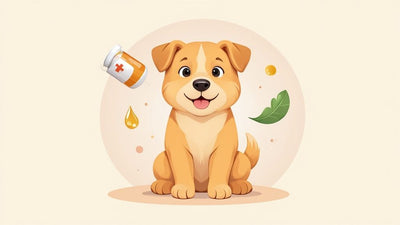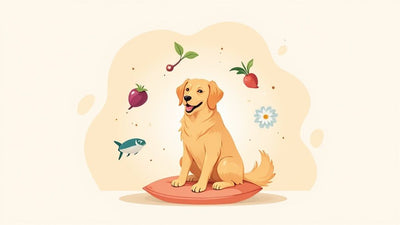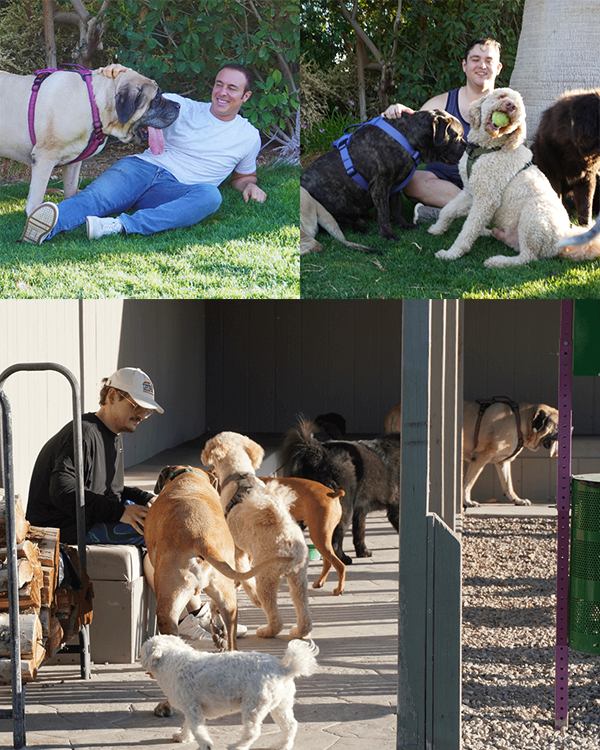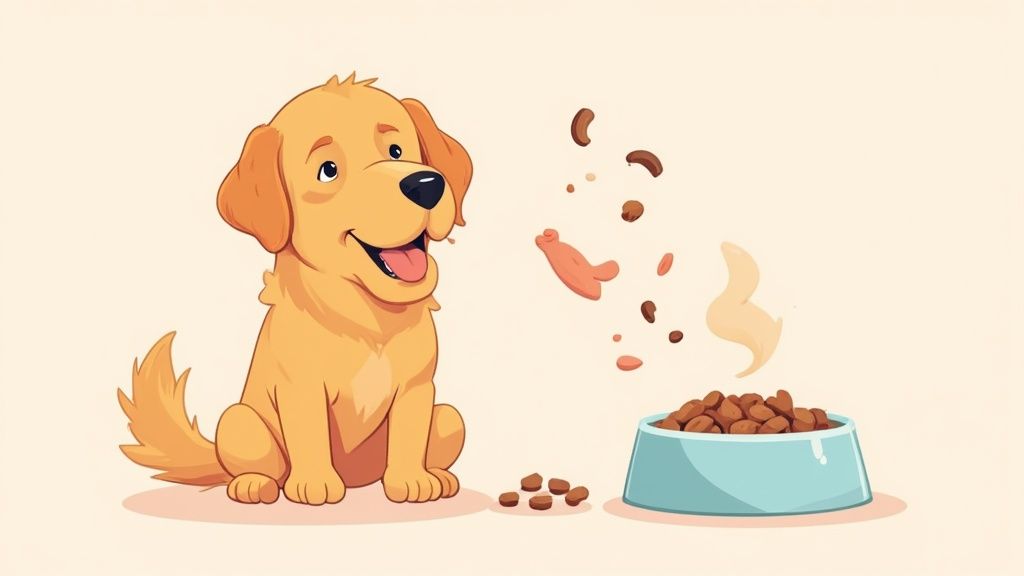
Top Dog Food to Reduce Shedding — Your Gentle Guide
We've all been there—seeing those little fur tumbleweeds rolling across the floor. Yes, the right dog food can absolutely help reduce shedding. The secret is giving your dog's body the high-quality building blocks it needs for strong, healthy hair follicles. A diet packed with digestible protein and essential fatty acids is your first and best defense against a constantly shedding coat.
Why Your Dog’s Diet Is the First Step
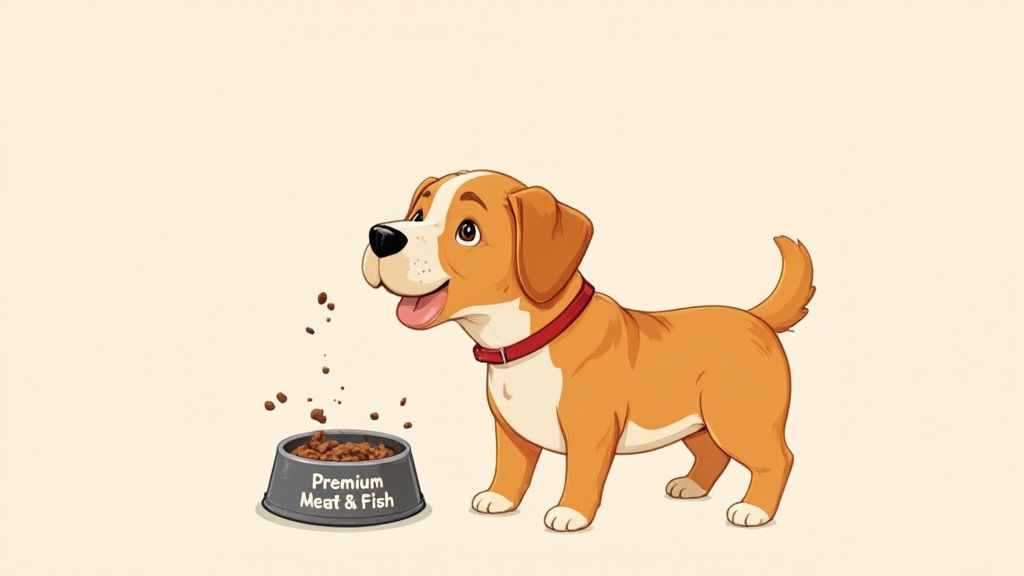
If you're tired of seeing fur everywhere, we get it. It can feel like a losing battle. It’s natural to think shedding is just a grooming problem, but the real journey to a healthier coat starts right in your dog's food bowl.
Honestly, your dog’s diet is the number one support system for their skin and coat. Subpar nutrition often leads to dry skin, brittle hair, and irritated follicles—a perfect storm for excessive shedding. Think of their food as the raw material their body uses for everything. The coat is often the first place you'll see signs of a nutritional shortfall.
The Foundation of a Strong Coat
A healthy coat isn't just about looks; it's a window into your dog's overall wellness. When a dog isn't getting all the nutrients they need, their body is smart—it sends the limited resources to vital organs first. The skin and coat get the leftovers, which can result in dull, weak hair that breaks off and sheds way too easily.
On the other hand, a nutrient-rich diet provides more than enough for both critical functions and a vibrant, resilient coat. This isn't about a miracle fix, but about providing consistent, high-quality nourishment day in and day out.
Small improvements matter. A diet that nurtures the skin is the most fundamental step you can take to see fewer fur drifts and enjoy more good days together.
The Power of Protein
We can't talk about coat health without getting serious about protein. Why? Because your dog's hair is made almost entirely of it. In fact, studies have shown that about 90% of a dog's fur is protein. This really drives home why top-notch protein sources are non-negotiable.
Named animal proteins—think real chicken, beef, or fish—deliver the specific amino acids required to build strong hair follicles that hold onto fur longer. You can explore more about these nutritional findings and see just how deeply they impact coat health.
This is exactly why grabbing just any bag of dog food won't cut it. The quality and digestibility of the protein source are what truly make a difference. By making sure your dog gets the right building blocks, you're giving their body what it needs to grow and maintain a healthier, less-sheddy coat from the inside out.
Get Your FREE Dog Brain Health Guide

Get instant FREE access to today's top ways to help your best friend live a longer, healthier, happier life.
- 39 value-packed pages of expert insights
- Early-detection tips for cognitive decline
- Top brain-boosting superfoods
- Vet-approved mental sharpness strategies
- Fun IQ tests for your dog
The Building Blocks of a Healthy, Low-Shed Coat
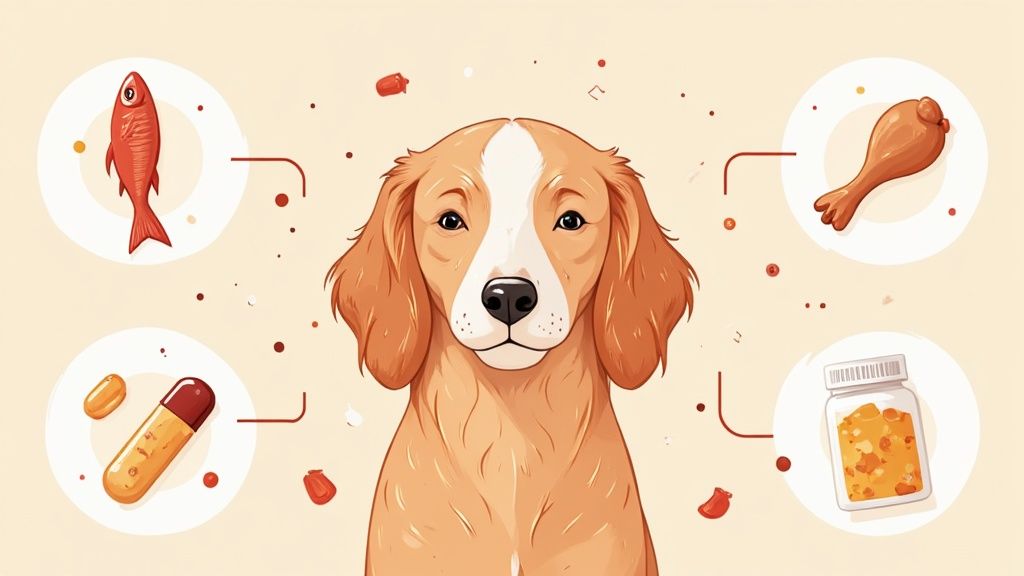
Standing in the pet food aisle can be overwhelming, right? Every bag promises the world, but what really makes a difference in how much your dog sheds? From our experience, it boils down to a handful of core nutrients that work from the inside out.
It’s not about a quick fix. Instead, think of it as consistently giving your dog the right tools to build a strong, resilient coat. You'd be surprised how much of a difference the right diet can make in taming that constant cloud of fur.
The Powerhouse Pair: Omega-3 and Omega-6
If there’s one thing to focus on for skin and coat health, it’s essential fatty acids. Think of Omega-3 and Omega-6 as the ultimate support team. These fats are absolutely crucial for maintaining the skin's natural moisture barrier, which is your dog's first line of defense against the dryness and irritation that often trigger excessive hair loss.
Because a dog's body can't produce these on its own, they have to come from their food. One of their biggest jobs is supporting a normal inflammatory response throughout the body, including the skin. Calm, healthy skin leads to stronger hair follicles that are much better at holding onto fur. Look for ingredients like fish oil (especially from salmon or sardines), flaxseed, and even sunflower oil.
Stronger Follicles Start With High-Quality Protein
Did you know that hair is made almost entirely of protein? This means the quality of the protein source in your dog's food directly impacts the strength of their coat. When you're reading a food label, seeing a specific, named animal protein like "salmon" or "chicken" listed first is a fantastic sign.
These high-quality sources provide the essential amino acids needed to build durable hair follicles. Weak follicles simply can't anchor hair effectively, and the result is more shedding. By providing top-notch protein, you're essentially reinforcing each strand of fur right from the root.
The Supporting Cast of Vital Micronutrients
While proteins and fats are the headliners, a team of micronutrients provides the crucial backup. These small but mighty vitamins and minerals are essential for all the biological processes that keep skin healthy and hair growing strong.
To give you a better idea of what to look for, here’s a quick-reference table.
| Nutrient | How It Helps Your Dog | Common Food Sources |
|---|---|---|
| Zinc | This mineral is vital for producing keratin, the very protein that makes up hair. It also helps support healthy, resilient skin. | Red meat, poultry, fish, beans |
| Biotin | A B-vitamin famous for its role in maintaining healthy skin and hair. It helps strengthen fur and reduce brittleness. | Eggs, salmon, sweet potatoes, liver |
| Vitamin E | A powerful antioxidant that helps protect skin cells from damage and supports overall skin health, creating a better foundation for hair growth. | Leafy greens, sunflower seeds, fish oil |
| Key Nutrients to Support a Healthy Coat |
Think of these nutrients as a complete package. When they work together, you create an internal environment that promotes a strong, shiny coat that stays on your dog—not on your furniture.
Every ingredient has a purpose. By focusing on these core nutrients, you can confidently choose a dog food to reduce shedding that genuinely supports your companion’s well-being, leading to more good days and less time with the vacuum.
And if you feel your dog's diet needs an extra boost, learning about the best skin and coat supplements for dogs can be a great next step on your journey to a healthier coat.
How to Choose the Right Food to Reduce Shedding
Walking down the dog food aisle can feel overwhelming. With so many bags plastered with promises and pictures of happy dogs, how do you know what’s actually going to help with that cloud of fur taking over your home?
The secret is learning to read the ingredient label. It’s less complicated than it sounds. You just need to know what to look for—and what to gently avoid.
Everything you need to know is usually packed into the first five ingredients. This is the core of the food, so you want to see high-quality, named protein sources leading the list. We're talking about things like "deboned chicken," "salmon," or "lamb," not vague descriptions. These are the building blocks for strong hair follicles that hold onto fur longer.
Look for Coat-Nourishing Ingredients
Once you've confirmed a solid protein source, your next move is to hunt for healthy fats. Keep an eye out for ingredients like fish oil (salmon is fantastic), flaxseed, and sunflower oil. These are packed with essential fatty acids that are absolute superstars for skin health. They work from the inside out to keep your dog's skin moisturized, which cuts down on the dryness and irritation that makes shedding worse.
Different proteins bring different benefits to the table, too.
- Fish-based foods are naturally loaded with Omega-3s, making them a top-tier choice for boosting coat health.
- Lamb is a great pick if you suspect your dog has sensitivities to common proteins like chicken. Sometimes, supporting a balanced immune response is all it takes to see a big reduction in shedding.
This infographic breaks down what to look for on a label. It’s a handy cheat sheet for your next trip to the pet store.
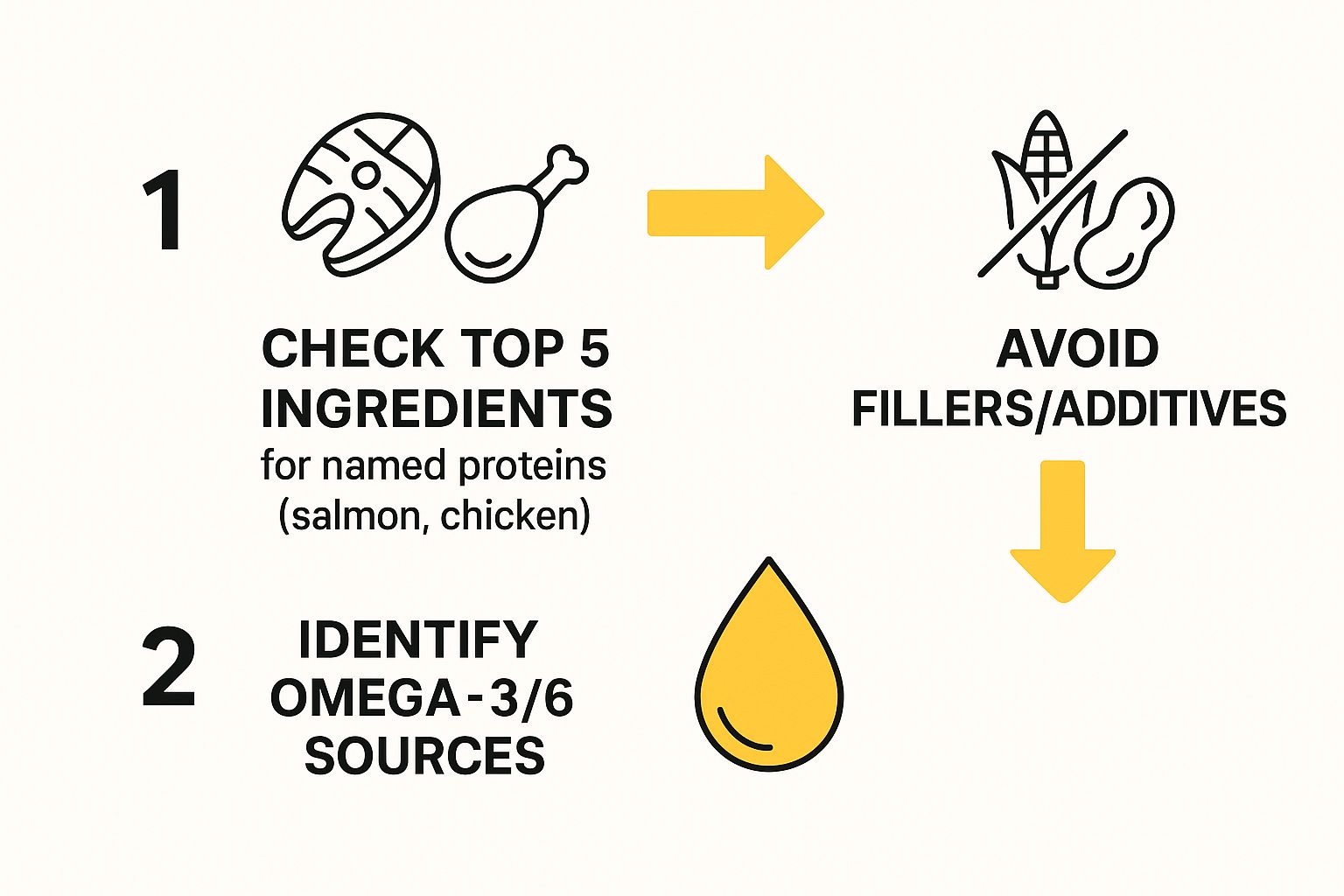
As you can see, a quick scan is often all you need to tell if a food is designed to truly nourish your dog’s skin and coat.
Ingredients to Gently Avoid
What's not in the bag is just as critical as what is. A lot of common dog food ingredients are just low-cost fillers that can actually contribute to skin problems.
We're firm believers in feeding dogs with purpose. Skipping the cheap fillers and artificial additives is a simple but effective step toward better overall health, and a shiny, less-sheddy coat is often the first sign you're on the right track.
Be wary of vague terms like "meat by-products" or "animal meal." If they can't name the animal, the quality is questionable. You should also sidestep foods heavy on fillers like corn, wheat, and soy, which are common allergens and don't do much for your dog's coat. The same goes for artificial colors, flavors, and preservatives—they can sometimes trigger sensitivities that lead to more shedding.
Choosing the right food gives you back a sense of control. By prioritizing whole, named ingredients, you're not just picking a dog food to reduce shedding; you're investing in your dog's long-term health. If you're ready to dive deeper into optimizing your dog's diet, check out our comprehensive guide to canine nutrition and supplements.
Gently Transitioning Your Dog to a New Diet
So, you’ve done your homework and picked out a fantastic new food packed with all the right stuff to get that shedding under control. We know it's exciting and you want to swap out their old kibble right away, but it's important to go slowly.
Making an abrupt change can really throw your dog's digestive system for a loop, leading to an upset stomach or just general discomfort. The last thing we want is for them to associate their new, healthy food with feeling unwell.
A slow and steady transition is the secret. Think of it as gently introducing their system to something new and giving it time to adapt. This approach is much kinder to their gut and sets you both up for success.
Your 10-Day Transition Plan
For most dogs, a 7-to-10-day timeline is the sweet spot. The idea is simple: you'll gradually mix more of the new food in with the old food each day. This gives their digestive enzymes a chance to catch up without getting overwhelmed.
Here’s a sample schedule that works well for most dogs. Remember, you know your companion best. If you know they have a sensitive stomach, don't be afraid to stretch this out over a full two weeks.
-
Days 1-3: Start with a mix of 75% old food and just 25% new food. This is a "getting to know you" phase for their digestive tract.
-
Days 4-6: Now you can shift to a 50/50 mix. We're halfway there! At this point, their system is getting more accustomed to the new ingredients.
-
Days 7-9: Time to tip the scales. Move to a ratio of 25% old food and 75% new food. Your dog is now eating a diet primarily made up of the new food.
-
Day 10 & Beyond: Success! You can now serve 100% new food. You've officially made the switch.
Keep an Eye on How They're Feeling
During this transition period, pay close attention to your dog. A little change in their stool is pretty normal, but if you notice any major digestive issues like diarrhea or vomiting, it’s a sign to pull back.
Simply revert to the previous food ratio for a couple more days before trying to move forward again. There's no race to the finish line here.
The goal isn't just to change their food, but to do it in a way that respects their body's needs. A comfortable transition ensures this positive change feels good right from the start.
By taking your time, you're doing more than just preventing an upset stomach. You’re making sure the new dog food to reduce shedding can get to work effectively, building the foundation for healthier skin and a much less furry house.

Support Your Dog's Brain Health with NeuroChew™
As mentioned in this article, NeuroChew is the first dog chew designed to support both cognitive function and healthy circulation. Perfect for dogs showing early signs of cognitive decline or for proactive brain health support.
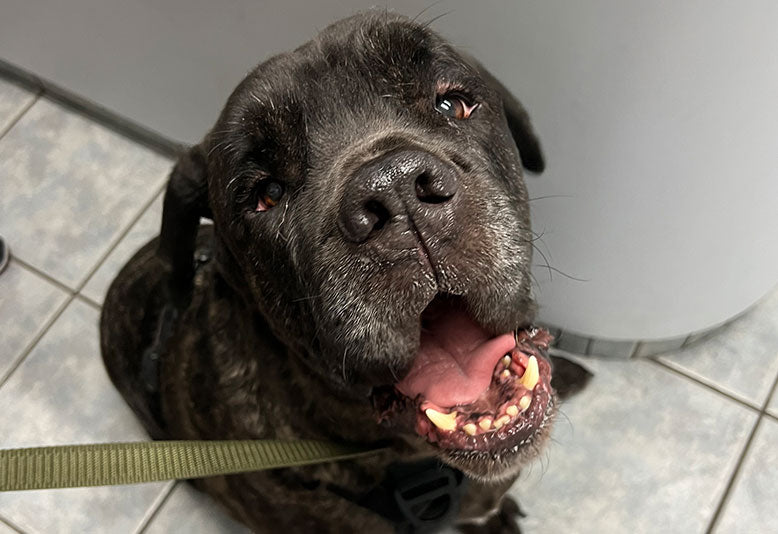
Real Results: How NeuroChew Helped Brutus Regain His Mental Clarity
Brutus was getting disoriented at night. After starting NeuroChew, he's more happy during the day and steady at night. He's back to his old self!
Beyond the Bowl: Simple Habits for a Healthier Coat
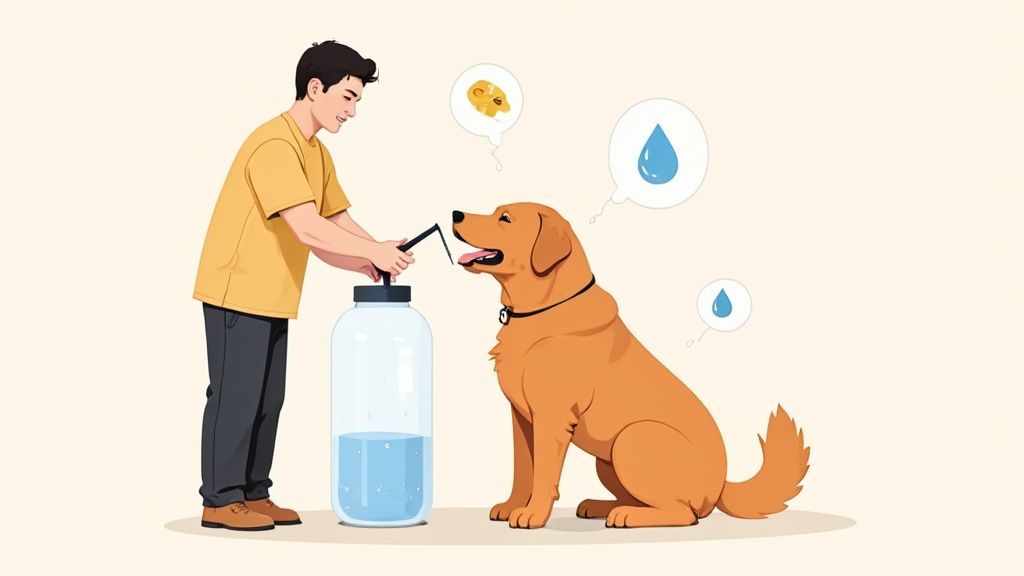
While the right diet is absolutely the cornerstone of a healthy coat, a few other simple, loving habits can make a surprising difference. Think of them as backup for the great nutrition you're already providing.
When you pair the right food with these gentle routines, you’re creating the perfect environment for a vibrant, healthy coat—and a lot less fur on your floors and furniture. These aren't huge, time-consuming chores. They’re just small additions to your day that support your dog's skin, strengthen their fur, and give you another excuse to connect with your best friend.
Find Your Rhythm with Regular Brushing
Life gets hectic, we understand. But carving out just a few minutes a couple of times a week for a good brushing session can work wonders for your dog's coat. This isn't just about cleaning up; it's a proactive step that removes all that loose, dead fur before it ever has a chance to decorate your sofa.
More than that, brushing helps distribute the natural oils from your dog's skin down the hair shafts. These oils are nature’s built-in conditioner, keeping the coat shiny, strong, and healthy. The motion also boosts blood flow to the skin, which is crucial for nourishing healthy hair follicles.
This isn't just a grooming task; it's a moment to connect. For many dogs, a gentle brushing session is a comforting ritual that strengthens your bond while directly improving their skin and coat.
Don't Underestimate the Power of Water
Hydration is one of those things that’s easy to overlook, but it’s incredibly important for every aspect of your dog’s health, especially their skin. When a dog is even slightly dehydrated, their skin loses elasticity, becoming dry and flaky. This creates a less-than-ideal foundation for healthy hair growth and can definitely lead to more shedding.
Make sure your dog has constant access to fresh, clean water. If you have a companion who isn't a big drinker, you can get creative. Try adding some moisture-rich, dog-safe snacks like small pieces of watermelon or cucumber to their diet. Switching to or supplementing with a high-quality wet food is another fantastic way to sneak in extra hydration.
Consider a Little Extra Support from Supplements
Even with a top-notch diet, some dogs just need an extra boost. This is where a well-chosen supplement can really shine. Omega-3 fatty acids, especially from a quality fish oil, are famous for their ability to support a normal inflammatory response and promote supple, healthy skin.
If your dog struggles with dry, itchy skin, these supplements can offer some much-needed comfort from the inside out. Of course, you’ll want to do a little research to understand the benefits and proper dosage for your dog. If you're curious about how this could help your companion, our guide on Alaskan salmon oil for dogs is a great place to start. Every dog is different, but the right supplement can be the perfect partner to a nutrient-rich dog food to reduce shedding.
Common Questions About Diet and Dog Shedding
It’s totally normal to have a few questions when you start making changes to your dog’s diet. In fact, it’s a good sign! It means you’re invested in getting it right for your best friend.
Let's walk through some of the most common things we hear from dog parents who are trying to get a handle on all that fur.
How Long Until I See a Difference in Shedding?
This is the big one, isn't it? You've made the switch, and now you're eagerly checking the floor (and your clothes) for signs of improvement.
Patience is key on this journey. A dog's hair growth cycle is a slow and steady process. You can generally expect to see a real, noticeable difference in your dog's coat and a drop in shedding within 6 to 12 weeks.
That timeframe gives the body enough time to push out the old, weaker fur and for those new, healthier hair follicles to grow in strong. Try to celebrate the small wins along the way—a bit more shine to their coat, less dander, or maybe just one less fur tumbleweed in the hallway. Those are all signs of progress.
Are Grain-Free Diets Better for Reducing Shedding?
This is a hot topic, and honestly, the answer is "it depends." For a dog that genuinely has a food sensitivity to a particular grain, going grain-free can make a world of difference. It helps calm the skin inflammation that’s causing them to shed excessively in the first place.
However, for most dogs, the grain-free label itself isn't a magic bullet. What truly matters are high-quality, named protein sources and the right balance of essential fatty acids. A top-notch, grain-inclusive food will do far more for your dog's coat than a low-quality grain-free one.
The real goal is a diet packed with the specific nutrients that build a healthy coat. Whether grains are part of that recipe is secondary to the quality of the protein and fat.
Can I Just Add Fish Oil Instead of Changing Food?
Adding a good fish oil supplement can absolutely give your dog's coat a boost, but it generally can't fix a subpar diet.
Think of it this way: their daily food is the foundation of their health. If that foundation is built with poor materials, adding a fancy new window (the fish oil) isn't going to solve the underlying problem.
For results that truly last, start with a high-quality base diet first. Then, you can use a supplement like fish oil for an extra, targeted boost. That way, you’re supporting your dog’s health on solid ground.
When Should I Worry Shedding Is a Medical Issue?
While changing your dog's diet can solve a lot of shedding woes, it's crucial to know when something more serious might be at play. Your vet is always your best resource.
It's time to make a call to the vet if you see any of these signs:
- Bald patches or areas where the fur is noticeably thinning.
- Skin that looks red, irritated, or inflamed.
- Constant scratching, obsessive licking, or biting at their skin.
- The shedding is happening alongside other symptoms, like lethargy or a change in appetite.
You know your dog better than anyone. If your gut tells you something isn’t right, a quick check-up can give you peace of mind and get your companion the help they need, no matter the cause.
At Furever Active, our mission is to support your dog's health at every stage of life. While our focus is on cognitive wellness, we know that a healthy body and a healthy mind go hand-in-hand. Explore how our science-backed supplements can be part of your dog’s holistic wellness plan at https://fureveractive.com.
Share This Article

Support Your Dog's Brain Health with NeuroChew™
The first dog chew that supports both brain function and healthy circulation. Perfect for dogs of all ages.
- Enhances cognitive function & mental clarity
- Reduces anxiety without sedation
- Supports healthy blood circulation
- Made in USA with natural ingredients
60-Day Money-Back Guarantee • Free Shipping



